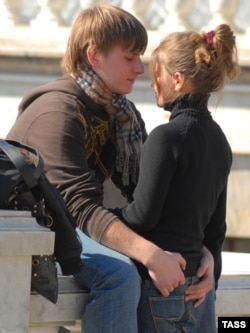MOSCOW -- Dilyara Latypova is a gynecologist in the Russian republic of Tatarstan. With more than 25 years of experience, she's seen some progress in family planning since the days of the Soviet Union, when such topics were largely taboo.
Still, she says, the situation today is far from ideal. For many women, the most common method of birth control remains a Soviet-era holdover: abortion.
"Young women who think that having an abortion is an easy thing are wrong," Latypova tells RFE/RL's Tatar-Bashkir Service. "An abortion is not only an operation. It's a deep psychological trauma for a woman. This is an operation that causes a woman physical and moral pain. I don't think it's the right decision."
Despite an abundance of new family-planning options, Latypova says lack of public awareness and prohibitive expenses -- like $25 monthly packs of birth control pills -- mean many women still see abortion as their only choice.
"Students and young girls can't afford birth control. Many girls are afraid to talk about it with their mothers and ask for money," she says. "An unplanned pregnancy can cause them enormous stress. They immediately opt for an abortion, and don't even tell their parents or boyfriends."
Russia was the first country in the world to legalize abortion, in 1920. The procedure was briefly driven underground, when Soviet leader Josef Stalin banned abortion in an attempt to encourage women to have larger families.
But after Stalin’s death in 1953, the ban was lifted. A decade later, the practice had become so common that the USSR officially registered 5.5 million abortions, compared to just 2 million live births.
A Private Matter
The number of abortions has fallen dramatically since then. The most recent available figures, for 2006, show 1.6 million abortions compared to 1.5 million live births -- a dismal figure, especially in a country struggling with a looming demographic crisis.
Women are entitled to abortions up until the 12th week of pregnancy, and -- unlike in many countries -- are not obligated to alert relatives or give a reason for requesting the procedure.
The relative ease of getting an abortion, in fact, has blinded many women to the numerous health risks associated with the process, especially for those who turn to it more than once. "The complications include bleeding and inflammation in the short term," says Lyubov Yerofeyeva, the director of the Russian Family Planning Association, an NGO that works to improve sex education in Russia. "In the long term, the most severe complication could be infertility."
Yerofeyeva is speaking in a brightly lit office in central Moscow whose walls are adorned with posters of cuddly babies. But Yerofeyeva and other association employees can also paint a stark picture of the reality of abortion in Russia today.
Sex education is not part of the national curriculum in Russia. So when most young people become sexually active, at around the age of 16, Yerofeyeva says they know almost nothing about how women become pregnant.
"You can't say the idea of family planning and birth control is flourishing," she says. "The tradition in Russia is not to talk about sexuality loudly, not to tackle these issues -- even within a family, even between husband and wife. Sometimes they’re not even communicating about their own sexual relations. These issues have always been very closed."
Growing Options
Part of the reason abortions were so prevalent during the Soviet era, health professionals say, was that contraceptives were so unreliable. Oral contraception was not available and more often than not, Soviet-made condoms and intrauterine devices didn’t work.
In the years after the Soviet collapse, before the expense grew too great, some gynecological clinics attempted to provide birth control for free, a practice that has proved successful in places like the United Kingdom.
The number of Russian women who use the pill as their primary form of birth control remains low -- between 3 and 13 percent, as compared to 52 percent in Europe. The predominant form of preventive birth control is the highly uncertain rhythm method. But Vladimir Shchigolev at the Moscow office of the World Health Organization says the situation is improving.
"At the moment, the younger generation knows more about family planning, and they have better access to family planning services. Today, they can go to the pharmacy and buy contraceptive pills, condoms, modern IUDs that are quite different from Soviet IUDs -- they are absolutely safe," Shchigolev says. "Of course they talk about abortion, but they talk about abortion as not a good way to prevent pregnancy and to plan a family.”
Abortion techniques have come a long way since the Soviet era, when 35-year-old Olga Lipovskaya related her experience in Francine du Plessix Gray’s acclaimed book "Soviet Women Walking the Tightrope."
“You stand in line before the door of the operating room, waiting to be taken in,” she says. “Then it's your turn, and you go into a hall splattered with blood, where two doctors are aborting seven or eight women at the same time; they're usually very rough and rude. If you're lucky they give you a little sedative.”
According to du Plessix Gray, Olga estimated that she had had about 14 abortions in total, and she knew women who had had as many as 25.
'Huge Psychological Trauma'
Today, modern techniques make the experience less traumatic and dangerous, but Natalia Vartapetova, the director of a Russian NGO called the Institute of Family Health says complications following abortions are still widespread.
"Unfortunately, still, the consequences of abortion are among the key causes of maternal mortality in Russia," she says. "One of the problems, perhaps, is infection control -- infection and sepsis afterward -- or other complications, like hemorrhage. Infertility, as well -- we know about one-third of infertility is due to previous abortions."
But for all that, the situation is improving, Vartapetova says. One of her projects is to educate health professionals about modern methods of birth control, and in the 20 or so regions where the programs are taking place, abortion rates have fallen.
And with the population level in severe decline -- demographers estimate it could fall below 100 million by 2050, from 150 million in 1992 -- the Russian government is also keen to tackle the issue of abortion. Last year, then-President Vladimir Putin introduced a long-term project to encourage women to have families with more than one child.
The pro-Kremlin youth group Nashi this year staged a demonstration to protest abortion, adorning rows of cemetery-style crosses with signs reading "architect," "driver," "editor," and other professions -- a nod to the potential labor lost to terminated pregnancies. (Nashi's conservative social streak extends to birth control; the group has protested against condoms and other preventive family-planning methods.)
Vartapetova warns that attempts to prevent abortions or to restrict access to birth control would be a mistake. "When we talk about the demographic crisis, quite often there's a misunderstanding -- that family planning leads to smaller family size. International evidence that shows that that's not true -- and that family planning actually improves women's health and decreases abortion rates. But this information isn't that well-known among our policymakers.”
Doctors like Latypova in Tatarstan are also quick to remind women of the enormous emotional cost that abortion can inflict. While the topic of abortion does not spark the kind of fierce moral debate seen in countries like the United States, Latypova says terminating a pregnancy can be a devastating experience.
"You can't compare the emotional state of a woman who undergoes an abortion with anything else. As both a doctor and a mother, I can say that it's a huge psychological trauma. There are very few women who can just breezily say, 'oh, I had an abortion.' I think there's no abortion that doesn't leave its mark on a woman."
RFE/RL's Tatar-Bashkir Service contributed to this report
















